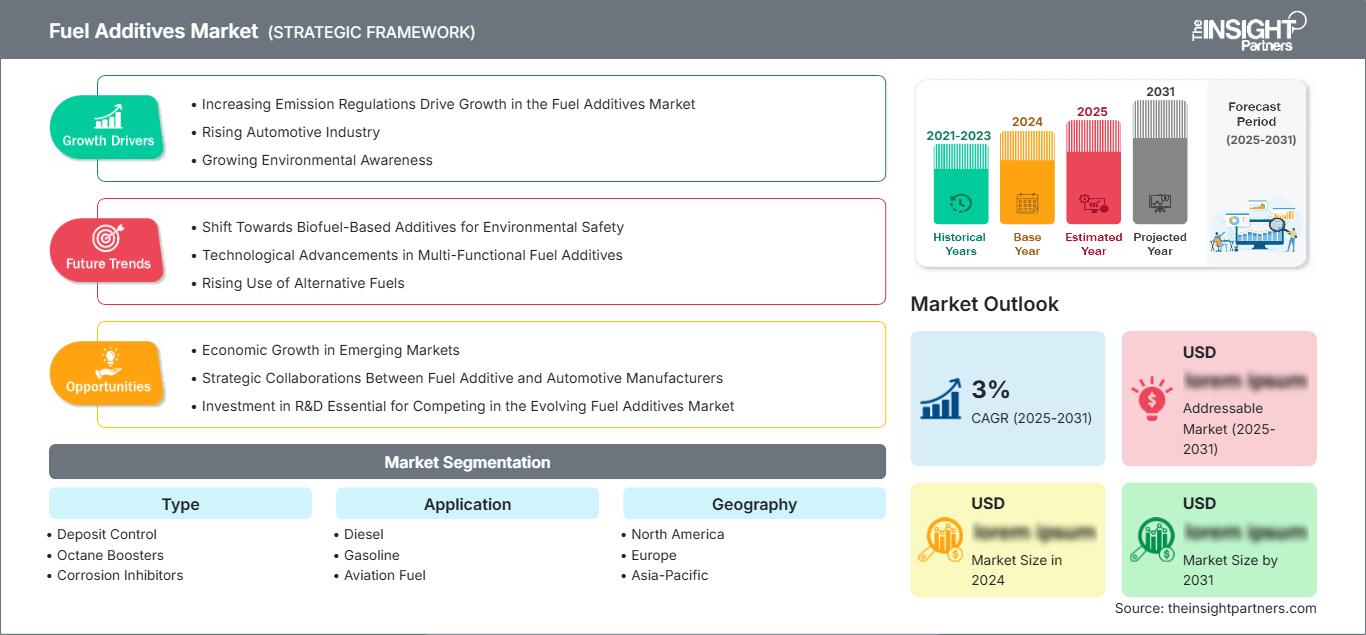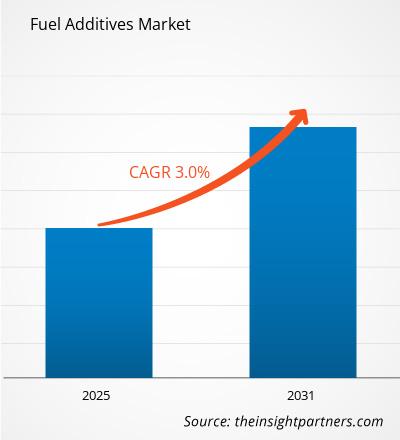Le marché des additifs pour carburants devrait enregistrer un TCAC de 3 % entre 2025 et 2031, avec une taille de marché passant de XX millions de dollars américains en 2024 à XX millions de dollars américains d'ici 2031.
Le rapport sur le marché des additifs pour carburants est segmenté par type (contrôle des dépôts, boosters d'octane, inhibiteurs de corrosion, agents antidétonants, antioxydants, stabilisants, additifs de lubrification, améliorants de cétane, etc.). Le marché est segmenté en fonction de l'application (diesel, essence, carburant aviation, etc.). L'analyse mondiale est ensuite ventilée au niveau régional et par principaux pays. La taille et les prévisions du marché aux niveaux mondial, régional et national pour tous les segments de marché clés sont couvertes. Le rapport présente la valeur en USD pour l'analyse, les segments, les régions et les pays ci-dessus. Il couvre les tendances du marché, ainsi que la dynamique du marché, notamment les moteurs, les contraintes et les principales opportunités. Français Le rapport couvre également le paysage industriel et l'analyse de la concurrence, notamment la concentration du marché, l'analyse de la carte thermique, les principaux acteurs et les développements récents du marché.
Objectif du rapport
Le rapport sur le marché des additifs pour carburants de The Insight Partners vise à décrire le paysage actuel et la croissance future, les principaux facteurs moteurs, les défis et les opportunités. Cela fournira des informations à diverses parties prenantes commerciales, telles que :
- Fournisseurs de technologies/Fabricants : Comprendre l'évolution de la dynamique du marché et connaître les opportunités de croissance potentielles, leur permettant de prendre des décisions stratégiques éclairées.
- Investisseurs : Effectuer une analyse complète des tendances concernant le taux de croissance du marché, les projections financières du marché et les opportunités qui existent tout au long de la chaîne de valeur.
- Organismes de réglementation : Réglementer les politiques et surveiller les activités du marché afin de minimiser les abus, de préserver la confiance des investisseurs et de maintenir l'intégrité et la stabilité du marché.
Type de segmentation du marché des additifs pour carburant
- Contrôle des dépôts
- Boosters d'octane
- Inhibiteurs de corrosion
- Agents antidétonants
- Antioxydants
- Stabilisants
- Additifs de lubrification
- Améliorants de cétane
Application
- Diesel
- Essence
- Carburant d'aviation
Vous bénéficierez d’une personnalisation sur n’importe quel rapport - gratuitement - y compris des parties de ce rapport, ou une analyse au niveau du pays, un pack de données Excel, ainsi que de profiter d’offres exceptionnelles et de réductions pour les start-ups et les universités
Marché des additifs pour carburants: Perspectives stratégiques

- Obtenez les principales tendances clés du marché de ce rapport.Cet échantillon GRATUIT comprendra une analyse de données, allant des tendances du marché aux estimations et prévisions.
Moteurs de croissance du marché des additifs pour carburants
- La réglementation croissante sur les émissions stimule la croissance du marché des additifs pour carburants : les restrictions croissantes en matière d'économie de carburant et d'émissions constituent l'un des principaux facteurs influençant le marché des additifs pour carburants. De nos jours, les gouvernements du monde entier mettent en place des systèmes civilisés afin de limiter les émissions de gaz à effet de serre et d'améliorer la qualité de l'écosystème. La pollution sonore a également favorisé le développement d'additifs pour carburants, qui contribuent à améliorer la productivité des moteurs, à améliorer l'efficacité de la combustion et à réduire les émissions toxiques, rendant les voitures plus écologiques.
- Industrie automobile en plein essor : la croissance globale de l'industrie automobile est observée dans toutes les régions du monde, et en particulier dans les pays en développement. Là où le taux de motorisation est élevé, il existe une demande correspondante de carburants hautes performances. Les additifs pour carburants sont importants pour améliorer la qualité du carburant utilisé, maintenir le bon fonctionnement du moteur et le protéger d'une usure excessive. Les tendances actuelles sont renforcées par la demande croissante de voitures haut de gamme et de sport, qui nécessitent souvent des additifs de carburant avancés pour que leurs moteurs fonctionnent efficacement.
- Sensibilisation croissante à l'environnement : La population comprend de plus en plus l'importance de l'environnement et du développement durable, ce qui incite les consommateurs et les industries à modifier leurs préférences en matière de carburants utilisés au profit de carburants plus propres. Les additifs qui contribuent à réduire l'accumulation de carbone, à améliorer la conservation du carburant et à réduire les émissions sont de plus en plus demandés. Il en va de même pour d'autres industries comme l'aviation et la marine, où les autorités de réglementation s'efforcent d'utiliser des carburants plus propres et de mener leurs opérations de manière efficace.
Tendances futures du marché des additifs pour carburants
- Évolution vers des additifs à base de biocarburants pour la sécurité environnementale : Un processus d'amélioration et de mise en œuvre d'additifs à base de biocarburants est actuellement en cours. L'accent mis sur la sécurité environnementale a fait évoluer l'attention des fabricants, passant des simples additifs améliorant les performances à ceux qui améliorent également les performances du carburant tout en intégrant des jouets respectueux de l'environnement. Ces biocarburants modifient la consommation pendant le processus de combustion, contribuant ainsi à réduire la quantité de combustibles fossiles utilisés.
- Progrès technologiques dans les additifs multifonctionnels pour carburants : Le marché des additifs pour carburants connaît une évolution technologique rapide. L'un des changements notables est l'introduction d'additifs multifonctionnels capables de résoudre plusieurs problèmes à la fois. Les progrès de la nanotechnologie, ainsi que de certains aspects du génie chimique, donnent lieu au développement d'additifs pour carburants plus puissants et plus fiables. Dans la plupart des cas, ces améliorations améliorent l'efficacité de la combustion, renforcent la stabilité du carburant et lui confèrent des propriétés anti-usure et anti-corrosion.
- Utilisation croissante des carburants alternatifs : L'utilisation de carburants alternatifs tels que le biodiesel, l'éthanol et le gaz naturel comprimé (GNC), entre autres, influence également le marché des additifs pour carburants. Avec l'utilisation croissante de ces émissions dans plusieurs industries, il existe un besoin d'additifs spécifiques pour optimiser leur utilisation dans les moteurs actuels. Cette tendance est typique de l'évolution globale visant à fournir des sources d'énergie plus propres et plus efficaces pour alimenter les opérations dans le secteur des transports et plusieurs autres secteurs.
Opportunités de marché des additifs pour carburants
- Croissance économique dans les marchés émergents : Le développement économique rapide enregistré dans la plupart des marchés émergents, en particulier dans les régions Asie-Pacifique et Amérique latine, s'est également ouvert, offrant une bonne opportunité pour l'expansion du marché des additifs pour carburants. Alors que ces régions développent leurs infrastructures et leurs systèmes de transport, ce processus accroît inévitablement le besoin de carburants et d'additifs pour carburants de meilleure qualité. Les entreprises peuvent exploiter cet essor en fabriquant leurs produits en ciblant spécifiquement les régions répondant aux spécifications réglementaires, appelées exigences, et celles des consommateurs.
- Collaborations stratégiques entre fabricants d'additifs pour carburants et fabricants automobiles : Les stratégies conjointes des fabricants d'additifs pour carburants avec les constructeurs automobiles permettent d'élargir la gamme des produits développés et d'améliorer leur efficacité. Cette collaboration se traduit souvent par des progrès dans la formulation des additifs et le développement technologique, contribuant ainsi à fournir des produits adaptés aux besoins changeants des consommateurs et des autorités de réglementation. Cette stratégie marketing serait également bénéfique pour la promotion et la vente d'additifs pour carburants sur d'autres segments de marché.
- L'investissement en R&D est essentiel pour être compétitif sur le marché en constante évolution des additifs pour carburants : L'investissement en R&D est, d'une certaine manière, indispensable pour survivre et même être compétitif sur le marché des additifs pour carburants. Quelques entreprises, susceptibles de dominer leurs concurrents sur ce segment, mènent des activités de R&D pour développer des additifs hautes performances. L'utilisation de matériaux, de formulations et de technologies appropriés permet de développer des produits répondant à la demande en carburants et à la durabilité environnementale.
Aperçu régional du marché des additifs pour carburants
Les tendances régionales et les facteurs influençant le marché des additifs pour carburants tout au long de la période de prévision ont été analysés en détail par les analystes de The Insight Partners. Cette section aborde également les segments et la répartition géographique du marché des additifs pour carburants en Amérique du Nord, en Europe, en Asie-Pacifique, au Moyen-Orient et en Afrique, ainsi qu'en Amérique du Sud et en Amérique centrale.
Portée du rapport sur le marché des additifs pour carburants
| Attribut de rapport | Détails |
|---|---|
| Taille du marché en 2024 | US$ XX million |
| Taille du marché par 2025-2031 | 2025-2031 |
| TCAC mondial (2025 - 2031) | 3% |
| Données historiques | 2021-2023 |
| Période de prévision | 2025-2031 |
| Segments couverts |
By Type
|
| Régions et pays couverts | Amérique du Nord
|
| Leaders du marché et profils d'entreprises clés |
|
Densité des acteurs du marché des additifs pour carburants : comprendre son impact sur la dynamique commerciale
Le marché des additifs pour carburants connaît une croissance rapide, portée par une demande croissante des utilisateurs finaux, due à des facteurs tels que l'évolution des préférences des consommateurs, les avancées technologiques et une meilleure connaissance des avantages du produit. Face à cette demande croissante, les entreprises élargissent leur offre, innovent pour répondre aux besoins des consommateurs et capitalisent sur les nouvelles tendances, ce qui alimente la croissance du marché.

- Obtenez le Marché des additifs pour carburants Aperçu des principaux acteurs clés
- Analyse historique (2 ans), année de base, prévision (7 ans) avec TCAC
- Analyse PEST et SWOT
- Taille du marché Valeur / Volume - Mondial, Régional, Pays
- Industrie et paysage concurrentiel
- Ensemble de données Excel
Rapports récents
Rapports connexes
Témoignages
Raison d'acheter
- Prise de décision éclairée
- Compréhension de la dynamique du marché
- Analyse concurrentielle
- Connaissances clients
- Prévisions de marché
- Atténuation des risques
- Planification stratégique
- Justification des investissements
- Identification des marchés émergents
- Amélioration des stratégies marketing
- Amélioration de l'efficacité opérationnelle
- Alignement sur les tendances réglementaires




















 Obtenez un échantillon gratuit pour - Marché des additifs pour carburants
Obtenez un échantillon gratuit pour - Marché des additifs pour carburants